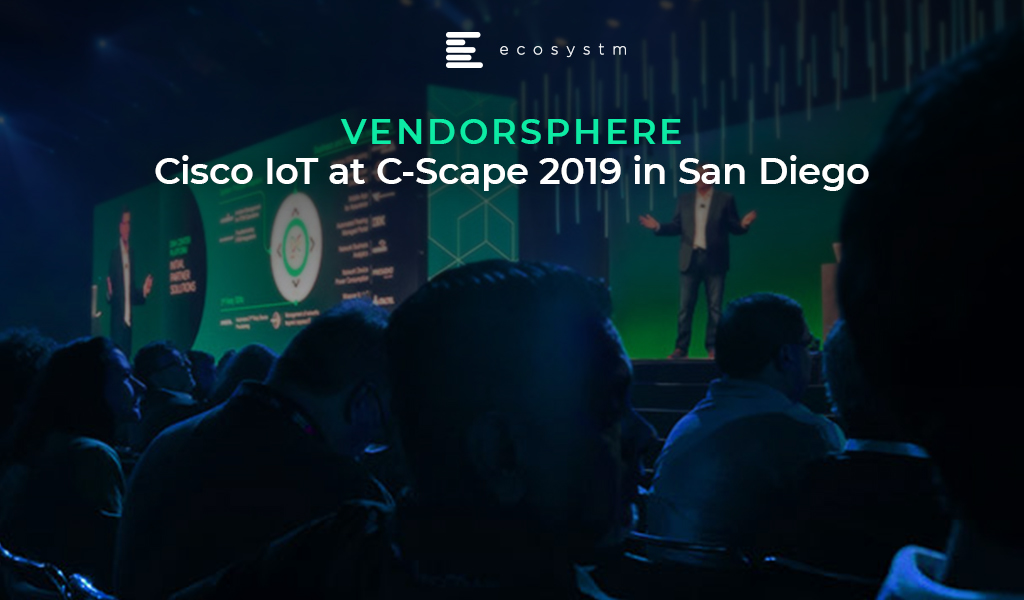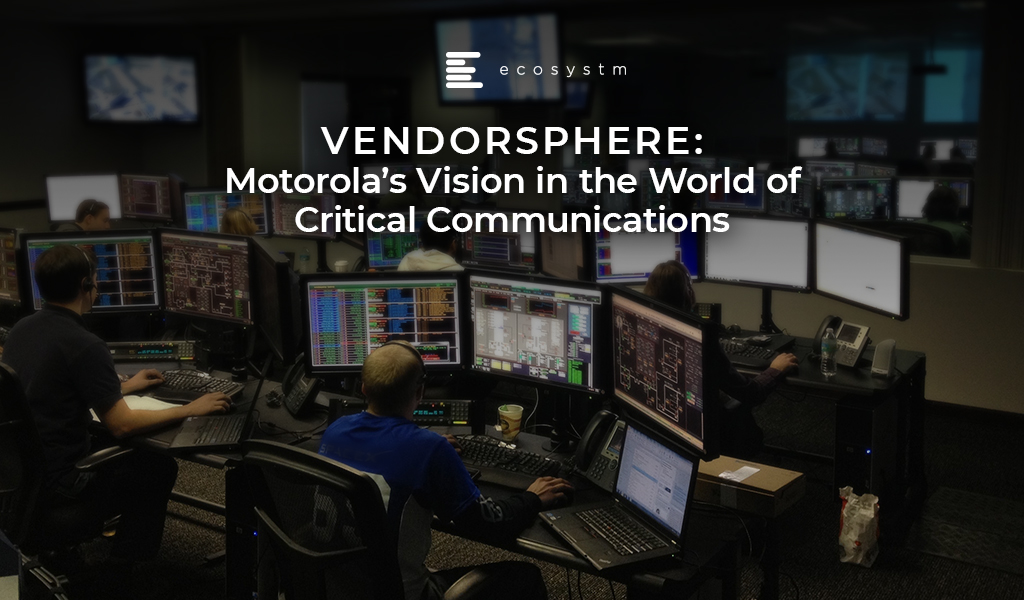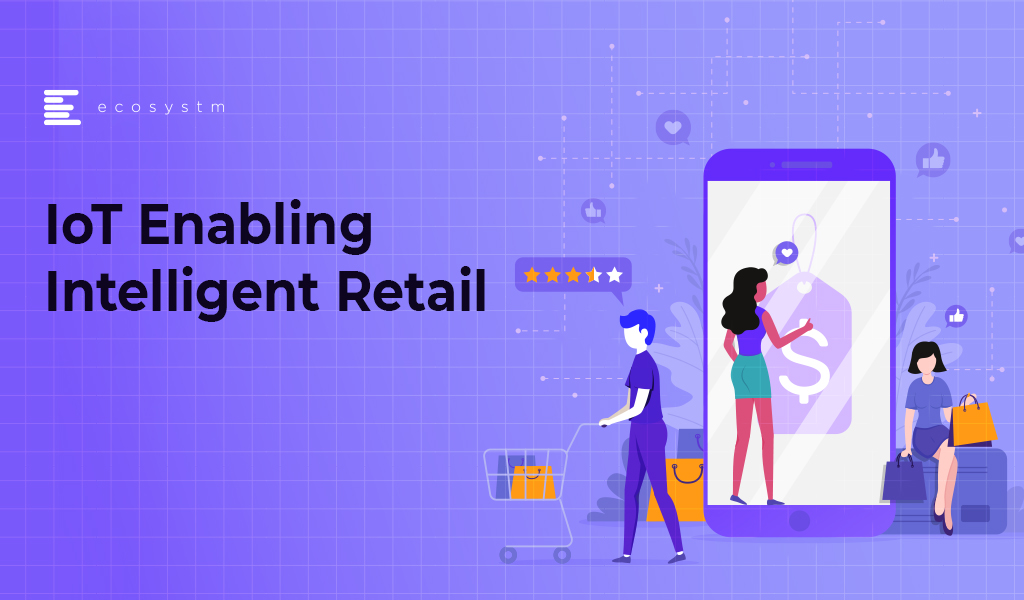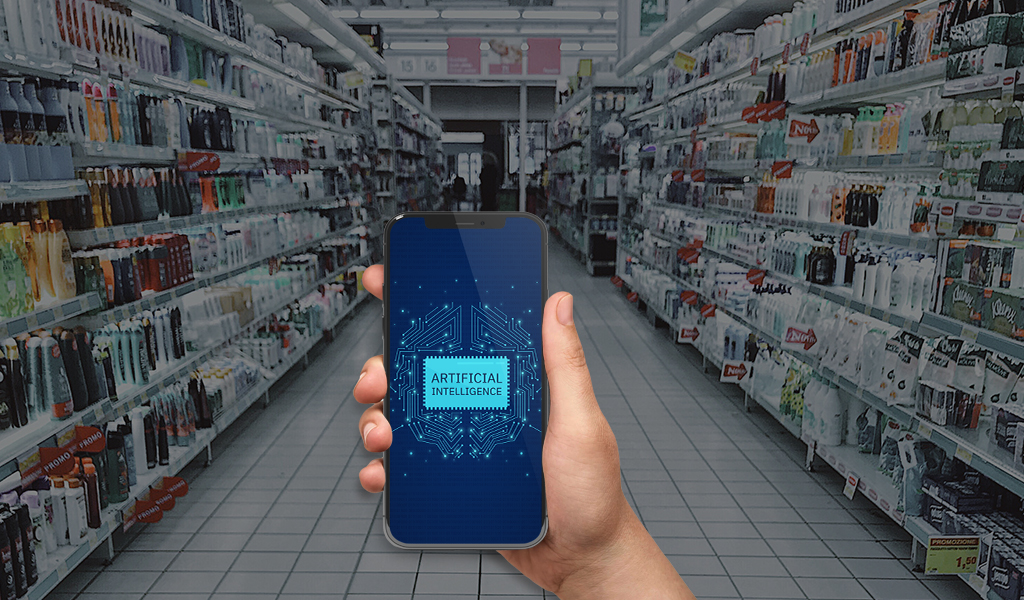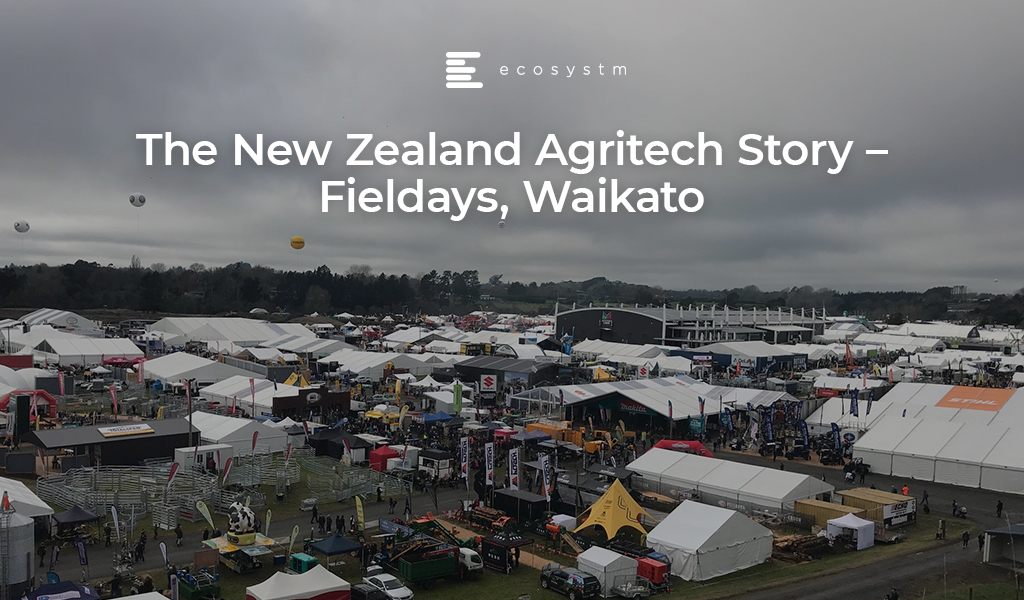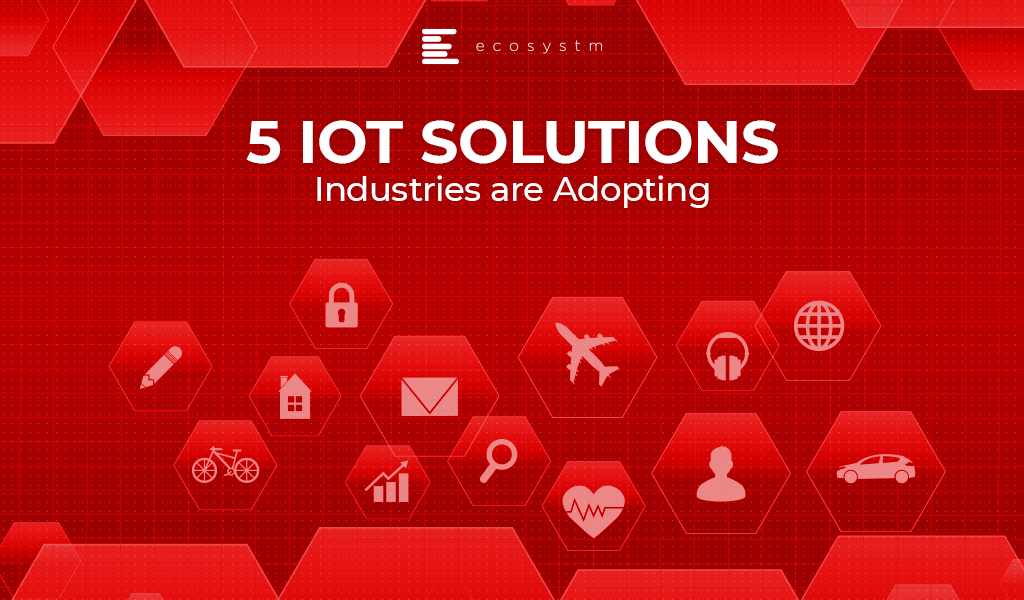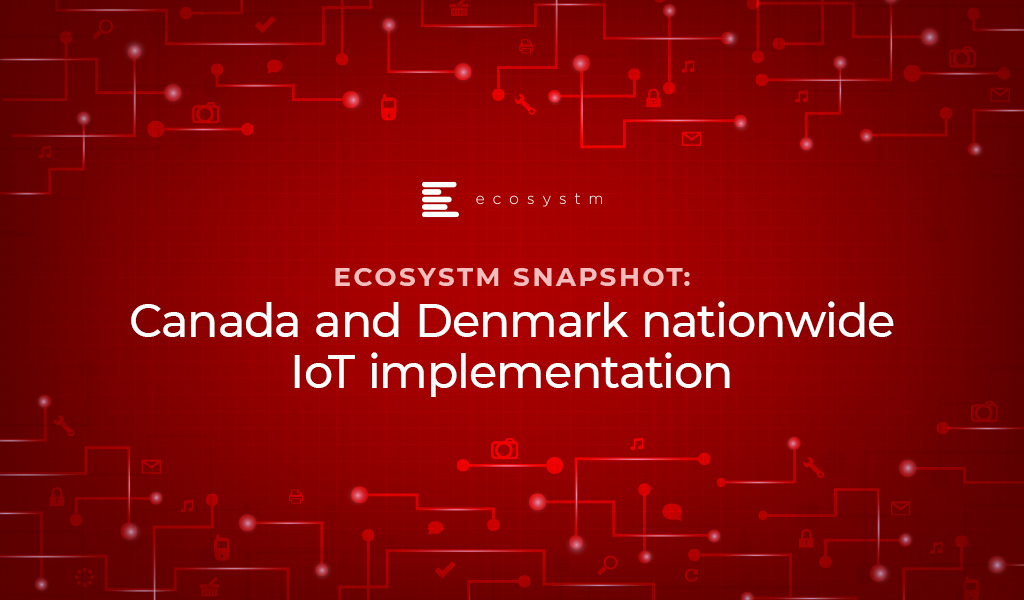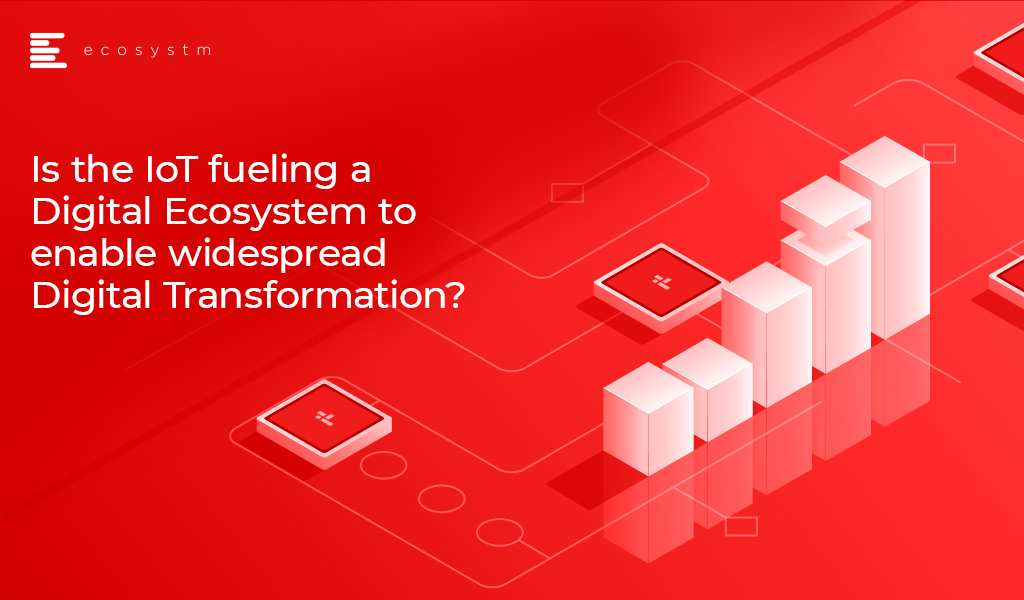During the past 12 months, Cisco has worked hard at refining and relaunching their IoT strategy. Initial overall impressions of the progress are good with strong alignment with both Cisco and their customer needs. Launching IoT to three different audiences at Cisco Live Barcelona, Hanover Messe and Cisco Live San Diego was critical as it enabled Cisco to talk to network, industry and enterprise audiences in a focused and personalised manner. However, there are other market dynamics at play that will challenge Cisco’s IoT Edge strategy and ecosystem play. Both the progress and challenges are discussed in this review.
Overall Rating B+
Much of the 2018-2019 efforts may be collated under three main categories.
- Hardware. Establish a hardware foundation from which any IoT device or customer can reap the benefits of Cisco’s larger corporate strategy built around initiatives such as Cisco DNA Center, Intent Based Networking, ACI and Security. With the acquisition of Sentryo and the refresh and launch of their routers, Cisco is now well placed to have legitimate discussions with Industrial IoT or IIoT customers and prospects. Bringing IBN functions to the edge of the network will enable Cisco’s customers to begin to develop richer business outcomes from the network. Rating: A-
- Developers: Raise the availability of IoT-based applications through Cisco’s DevNet developer community. Cisco has a significant advantage over their competitors by having over 500,000 developers who understand how to write apps for Cisco’s product line and who now have access to new types of data that can enrich traditional network outcomes. Over time this advantage will become more and more valuable as data becomes utilised across markets as well as within markets thus creating wealth in a much larger ecosystem. Rating: B+
- Partners: Transform their partner management through the Customer Experience (CX) program. Much of Cisco’s business is conducted through partners. It is a critical success factor for Cisco to enable the partners to be IoT-data savy. IoT will enable Cisco to accelerate the transition from product sales to higher value subscription services. However, based on discussions with customers, partners and Cisco management, we believe that there is much more work to integrate an IoT strategy in to CX. Rating: B-
The Industrial IoT (IIoT) and Cisco
Cisco identified the IIoT market as one where Cisco’s strengths in hardware, software and partner ecosystem will play well with their customers and prospects. While having a strong foothold in the industrial space, we believe that Cisco’s success will be much dependent on the customer’s workloads and what they want to achieve with their data as it is reducing the complexity between IT and OT (Operations Technology) issues. Cisco has addressed the IoT connectivity and network security at the edge of the network through its ruggedized routers while their competitors are building distributed computing environments. Competitors who are adopting a full IT stack at the edge of the network aim to offer up more OT-based industrial services as well as emerging innovation services such as digital twin, augmented reality and robotic process automation. One key consequence of a customer choosing either approach will result in differing partner ecosystems to form and support the customer. These ecosystems will also be different in how they are managed and by who manages them.
Our recent IoT study shows that while security (a sweet spot for Cisco’s strategy) remains extremely important to an organisation’s solution, technology integration is equally important. When vendors are considering implementing an industrial solution, they need to be able to provide an end-to-end solution that encompasses both the IoT Edge and the IoT Enterprise while smoothly bringing together the OT and IT procedures.
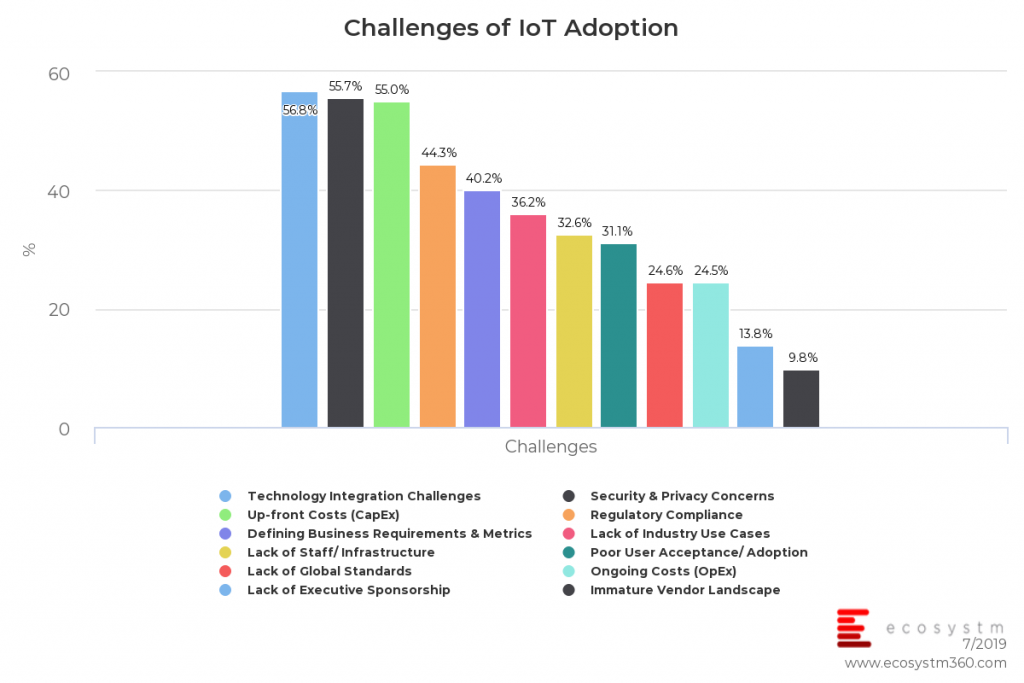
This all starts with an easy on-boarding of any IoT device that is secured and managed with confidence and reliability. The good news for Cisco is that these challenges are also a natural opportunity for Cisco’s partner organisation and systems integrators by creating a new styled IoT ecosystem. However, despite which hardware path an end-user takes, we believe that Cisco and others do not have all of the necessary components of the full ‘IoT’ stack to fulfil a complete solution. To that end, everything will pivot to the vendor who either has the better systems integrations partnership, or, plays in the strongest ecosystem.
IoT Services
Most of Cisco’s business is driven through partners and therefore any success for Cisco’s IoT strategy is dependent on how well they execute it. IoT will accelerate the shift from product based solutions to subscription/as a Service deliverables as more information is generated from the connected devices. and as such the Cisco partner community should be trained/incentivised to offer up IoT. Cisco partners are already undergoing their own business transformation as Cisco’s Customer Experience (CX) strategy is introduced to them. Having the IoT hardware align with the broader Cisco vision was critical to enabling any CX IoT strategy. However, partners may be in ‘transformation’ overload as they embrace the traditional Cisco customer needs and requirements and may be slower to take up the IoT opportunities.
Our IoT study shows that customers believe that the transition from products to services innovation is the highest scoring benefit from an IoT implementation.
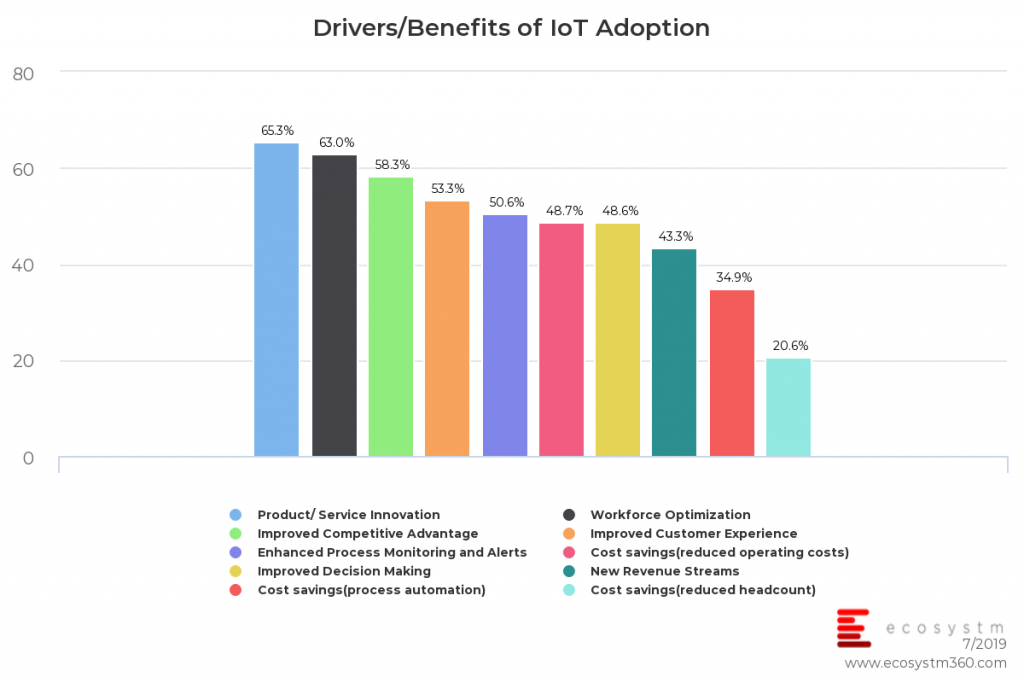
However, this is a difficult but critical part of any company aspiring to become a digitally driven business. An IoT strategy is a corner stone of this vision as it will provide the data to be able to run a services or subscription-based business model
Cisco is well positioned here but there is a maturity and readiness gap between Cisco and their customers. Patience will be a key asset as Cisco and their partners close technology gaps for their customers (e.g. adopting and implementing widespread analytics as part of the corporate digital strategy. Most customers are not ready to take advantage of IoT-based analytics outcomes and therefore the RoI case has not been fully articulated).
Finally, Cisco needs to address the mid-tier market with solutions that are compatible with budgets. While it is important to have an ecosystem of high calibre partners within systems integrators, we feel that there will be many customers who cannot afford Cisco’s end-to-end solution. As a result of this Cisco partners are still not ready to address the mid-tier market. Cisco will need to promote offerings across all markets by participating in high-, mid-, and low-end ecosystems. This may mean acknowledging non-5G licensed spectrum/ non WiFi solutions for the most cost sensitive customers for the sake of broader market and industry share.
Recommendations For Cisco IoT
The following are our recommended actions for Cisco IoT based on C-Scape and the prior 12 months of strategy rollout:
- Create stronger value proposition for network based IoT business outcomes. Customers are asking for end-to-end validation which means that Cisco needs to articulate a role with the likes of Salesforce, SAP and Microsoft to enhance customer’s enterprise management systems. This is where Cisco’s CX and partner organisation will also be challenged but can open up a lot of opportunity. Move the message up the value chain. More work has to be done with CX. More has to be done with developers.
- Articulate a stronger comprehensive Industry 4.0 solution that gives customers all of the application qualifiers to run on Cisco’s hardware. Cisco will be challenged by the IT-lead distributed IoT compute stack over its industrial strength routers. More marketing has to be invested in the IoT Edge campaigns.
- Segment the IoT market by customer maturity/readiness/size and their IoT connected assets. Based on asset churn and customer size will dictate the type of new IoT ecosystem that Cisco will either build, manage or participate. For example, an IoT solution of Capex intensive assets with longevity is very different for agriculture supply chain management. Segmentation is critical for Cisco to be successful.
Critical Communications World, 2019 – TCCA’s largest event in global public safety communication – was held in Kuala Lumpur in June. Mission-critical communications are essential to maintaining safety and security across a range from daily operations to extreme events including disaster recovery. A UN report estimated that economic losses from natural disasters could reach USD 160 billion annually by 2030.
I attended the event as a guest of Motorola Solutions – one of the leaders in this field. Many people associate Motorola only with phones not knowing that they have been the cornerstone of some of the largest critical communications deployments around the globe. For instance, Victoria Police completed its AUD 50M+ rollout of Motorola Solutions managed services, enabling almost 10,000 police officers across Victoria access to mobile devices loaded with smart apps, and data when and where they need it most.
Motorola’s ability to provide customers with a private network which is secure, robust and redundant in the event of disaster has also been one of the reasons for their success in the industry. In the event of natural disasters or terrorist attacks, situations can arise where networks will not be available to send and transport any information. Having a secure and private network is critical. That explains why some of the largest police departments in Asia work with Motorola and these include Singapore, Malaysia and Indonesia.x
Motorola acquired Australian mobile application developer Gridstone in 2016 and Avigilon, an advanced video surveillance and analytics provider in 2018. These acquisitions demonstrate how Motorola is innovating in the areas of software, video analytics and AI.
Key Takeaways:
Public Safety Moving to a Collaborative Platform with AI and Machine Learning
Andrew Sinclair, Global Software Chief for Motorola Solutions sees AI enhancing future command and control centres and allowing greater analytics of emergency calls. Call histories and transcriptions, the incident management stack, community engagement data and post incidence reporting are all important elements for command and control centres. Using AI to sieve through the information will empower the operator with the right data and to make the right on-the-spot decisions.
The Avigilon acquisition, enhances Motorola’s AI capabilities and less time is spent monitoring videos, giving first responders more time to do their jobs. The AI technology can make “sense” of the information by using natural language technology. For example, if asked to find a child in a red t-shirt, the cameras can detect the child and also create a fingerprint of the child. The solution enables faster incidence detection by using an edge computing platform. It gathers the information and processes it to relevant agencies making the search operation faster and more streamlined. The application of AI in the video monitoring space is still in its early days and the potential ahead for this technology is enormous.
The other area that can empower first responders better are voice activated devices. The popularity of Alexa and Echo in the consumer world will see greater innovation in the application of public safety solutions. For example, police officers responding to an emergency may have very little time to look at screens or attend to other applications that need touching or pressing of a button as time and attention is essential is such scenarios. The application of voice activated devices will be critical for easing the job of the police officer on the ground. This will not only save administrative work on activities such as transcription, but also help in creating better accounts of the actual happenings for potential court proceedings.
While it is still early days for a full-fledged AR deployment in public safety, there are potential use cases. For example, firemen standing outside a building to make sense of the surrounding area could use AR to send information back to the command and control centres.
The Growth of Cloud-driven Collaboration
Seng Heng Chuah, VP for Motorola APJ talked about the importance of all agencies in public safety to be more open and collaborative. For instance, currently most ambulance, police and fire departments work in silos and have their own apps and legacy systems. To achieve the Smart City or Safe City concept, collaborating and sharing information on one common platform will be key. He talked about the “Home Team” concept that the Singapore Government has achieved. Allowing all agencies to collaborate and share information will mean the ability to make faster decisions during a catastrophe. Making “sense” of the IoT, voice and video data will be important areas of innovation. Normally when a disaster happens, operators at command and control centres – as well as onsite staff – face elevated stress levels and accurate information can help alleviate that.
The move towards the public cloud is also becoming more relevant for agencies. In the past there was resistance and it was always about having the data on their own premises. In recent years more public safety agencies are embracing the cloud. When you have vast amounts of data from video, IoT devices and other data sources, it becomes expensive for public safety agencies to store the data on premise. Seng Heng talked about how public safety agencies are starting to “trust’’ the cloud more now. According to him, Microsoft has done a good job in working with local governments around the world, and their government clouds have many layers of certifications as well as a strong data centre footprint in countries. The collaboration between agencies and more importantly agencies embracing the cloud will drive greater efficiency in analysing, transcribing and storing the data.
The Rise of Outcome-based, Services-led Opportunities
Steve Crutchfield, VP of Motorola Solutions for ANZ, talked about how Motorola is a services-led business in the ANZ market. 45% of Motorola’s business in ANZ is comprised of managed services. The ANZ region is unique as it is seen as early adopters and innovators around public safety implementations. Organisations approach Motorola for the outcomes. Police and Ambulance for example in the state of Victoria use their services on a consumption model. Customers across Mining, Transportation, and Emergency Services want an end-to-end solution across the network, voice, video and analytics.
The need for a private and secure network is significant in several industries. In the mines, safety is of priority and as soon as the radio goes down it impacts productivity and when production stops that can results in huge losses for the mines. Hence the need for a reliable private network that is secure for the transportation of voice and video communication is critical.
Crutchfield talked about how the partner ecosystem is evolving with Motorola working with partners such as Telstra and Orion but increasingly looking for specialised line of business partners and data aggregation partners. Motorola works with 55 channel partners in the region.
Ecosystm Comment:
Motorola Solutions is an established player in providing an end-to-end solution in the critical communications segment. The company is innovating in the areas of software and services coupled with the application of AI. Dr Mahesh Saptharishi, CTO at Motorola Solutions talked about how AI will eventually evolve into “muscle memory”. That will mean that there is far greater “automatic’’ intelligence in helping the first responders make critical decisions when faced with a tough situation.
In the end the efficacy of critical communications solutions will not just be the technology stack, but the desire and ability for cross-agency collaboration. As public safety agencies analyse large volumes of data sets from the network right to the applications, they will have to embrace the cloud, and which will help them achieve scale and security when storing information in the cloud. From the discussions, it was clear that the public safety agencies have started acknowledging the need to do so and we can expect that shift to happen soon.
Motorola will need to keep evolving their channel partner model and start partnering with new providers that can help in delivering some of the end-to-end capabilities across Mobility, AI, software, analytics and IoT. Many of their traditional partners may not be able to be that provider as the company evolves into driving end-to-end intelligent data services for their clients. The company is playing in a unique space with very few competitors that can offer the breadth and depth of critical communications solutions.
The Retail industry faces constant disruption because of unpredictability and seasonality for reasons ranging from economic uncertainties to festive seasons. Technology adoption has emerged as a key differentiator between the success stories and the also-rans in the industry. The biggest example of this would probably be eCommerce heavyweights in China, that were revolutionised by digital technology, forcing global Retail counterparts to transform to compete. Emerging technologies are helping organisations drive customer loyalty and improve their supply chain for better cost efficiency.
Drivers of Technology Adoption in Retail
There are several factors that have made the Retail industry one of the leaders in technology adoption.
- Evolving Customer Preferences. Understandably, customers are kings in the Retail industry and their preferences drive the industry. For many years, customer loyalty was implemented through ‘loyalty programmes’ but today’s customers are not bound by cards and points, and factors such as same-day delivery, multiple payment options, on-the-spot problem resolution, and even invitations for exclusive events have a role to play in customer retention. The focus has shifted to better customer experience (CX). Retailers have access to immense data on their customers (which in turn raises concerns around data handling and compliance – requiring further investments in cybersecurity solutions), which is collected at every point of interaction and can be analysed for personalised and just-in-time offerings.
- Maturity of the Omnichannel. Omnichannel retailing has been gaining grounds since the advent of eCommerce. However, the proliferation of mobile apps enabled not only easy access and monitoring of loyalty programmes, but also advanced capabilities such as the real-time view of inventory, and incorporation of virtual assistants for CX – and are pushing traditional players in the Retail industry to innovate and adopt the technology. However, as omnichannel has become the norm, retailers are evaluating the channels they want a presence on. While experts predicted that a brick-and-mortar presence would become redundant, retailers are realising that while consumers do research on the Internet and apps, many prefer to inspect and buy at a physical shop. This requires better integration and supply chain visibility across all touchpoints.
- Globalisation of the Market. No longer can a retailer be sure of where the actual competition lies. One just has to look at the number of platforms and websites originating from Japan that have a presence across the globe to understand that competition can come from outside your country and very easily. Nor can they be sure of the best place to source their products as the world becomes one global market. In this global world, it is very important for retailers to have complete visibility of their supply chain, whether for a brick-and-mortar store or for eCommerce.
The global Ecosystm AI study reveals the top priorities for retailers (and etailers), focused on adopting emerging technologies (Figure 1). It is very clear that the top priorities are driving customer loyalty (through initiatives such as market segmentation and pricing optimisation) and supply chain optimisation (including demand forecasting and fraud detection, as procurement widens). 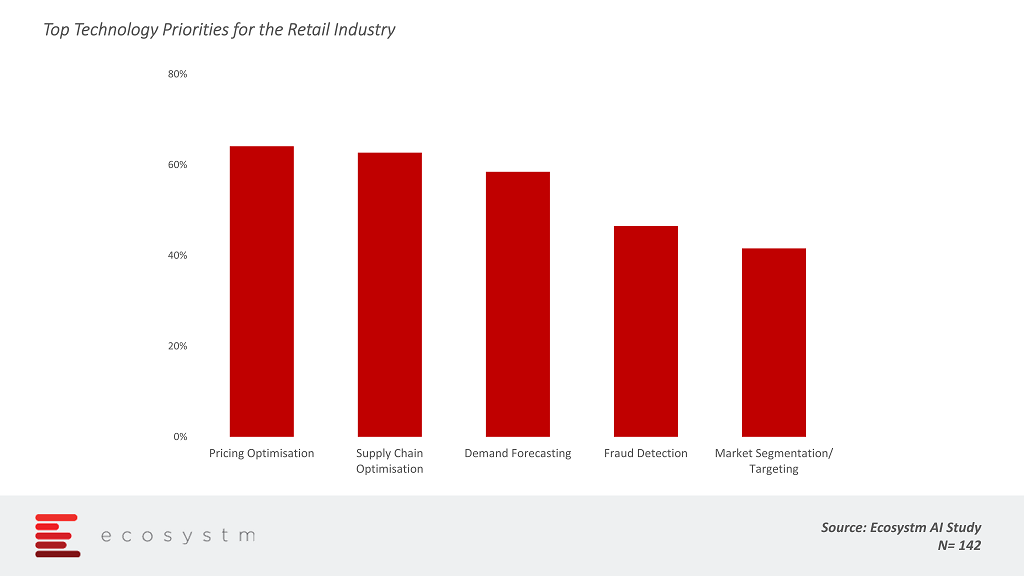
IoT as an Enabler of Retail Transformation
The Retail industry is particularly leveraging IoT as they are faced with the overwhelming need to transform. The global Ecosystm IoT study reveals the areas that organisations are looking to benefit from IoT implementations (Figure 2). Retail organisations are essentially looking to creating a competitive edge – cost savings are not high on the list of benefits they are looking at.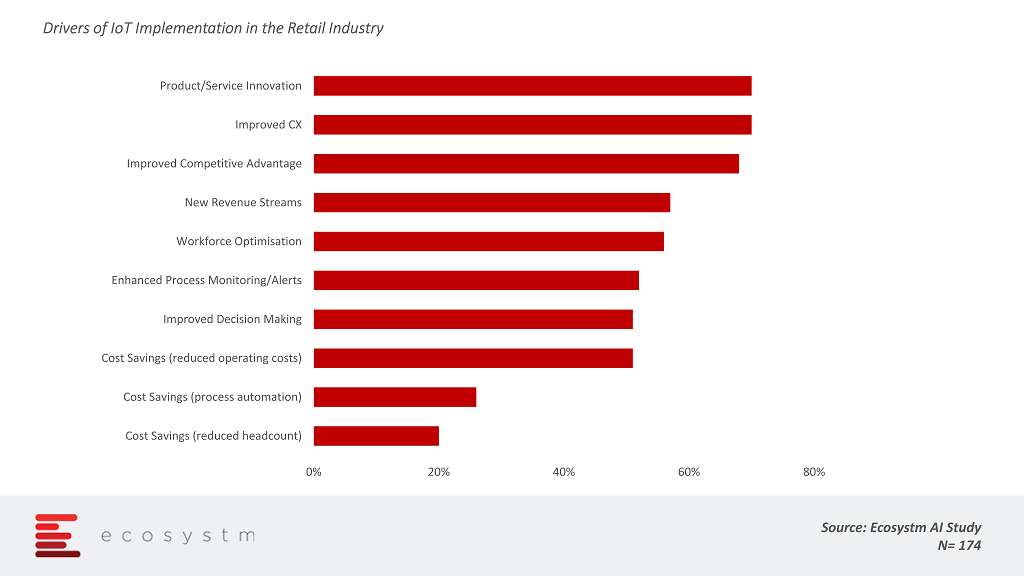
Several Retail organisations are deploying customer management IoT solutions such as payment systems, customer identity authentication (especially in eCommerce), Digital Signage, customer satisfaction measurement through smart buttons, and location-based marketing. Asset management IoT solutions such as IoT-based inventory and warehouse management are also gaining traction.
Examples of IoT Use in Retail
IoT for Customer Experience
- Automated POS terminals. Customers are put off by long queues, and automated checkout systems are improving CX. Caper’s plug-and-play cart-system is a shopping cart with a built-in barcode scanner and credit card swiper which automatically scans items when they are dropped in, with the help of image recognition cameras and weight measuring sensors.
- Smart Mirrors. Smart fitting rooms are transforming the way customers browse, try out and shop. Smart Mirrors enhance customers’ shopping experience through interactive fitting rooms which connect retailers and customers digitally. Rebecca Minkoff reinvented the dressing room using Smart Mirrors.
IoT for Marketing
- Digital Signage. Digital Signage has proved to be an effective way of target marketing, eliminating the need for employees to put up physical signs and enabling dissemination of the latest product news and promotions to the consumers. Advanced Digital Signs include heat-mapping to upsell items based on high-traffic areas. Prendi, an Australian design agency created an interactive retail experience that is intended for store managers to showcase the most popular products, provide information, and simplify the overall sales and purchase process. Customers can take time to easily navigate through store inventory on a single screen, order for items digitally, which is then sent to a salespersons’ handheld devices, allowing them to take the items over to the customers.
- Location-Based Marketing. Many retailers are collaborating with financial institutions and location-enabled apps to send push notifications on latest deals and offers straight to the customers’ devices, once they enter a demarcated location. This provides just-in-time data that increases app engagement and retention. Ukrainian hypermarket, Auchan, started a beacon pilot in Dec 2016 and kept adding new campaigns to strengthen the offerings in 2017. The hypermarket makes use of beacons to enable customers to receive notifications on navigation and promotions as they move through the store.
IoT for Supply Chain Optimisation
- Smart Shelves. Shelves have turned out to be more than just a surface for displaying and storing objects. Retail stores are utilising RFID readers, weight sensors, proximity sensors, and 3D cameras for real-time visibility on inventory, layout, and shopper preferences. For FMCG products, monitoring the shelf life of perishable goods and proactive reorder alerts are extremely useful. Kroger Smart shelves are designed to offer digital support – they show ads, digital coupons that consumers can easily add to their mobile devices and changed prices as stores calibrate their product pricing. The shelves are built on top of sensors that keep track of products and real-time in-store inventory counts.
- Remote Supply Chain. Retailers are looking to create a competitive edge and grow profits by optimising and digitising their supply chain management through IoT. Tive helps users keep real-time tabs on the condition of their shipped goods, notifying them about shock, vibration, tilt and other factors that might detrimentally affect those goods. Doing so allows retailers to expedite a replacement shipment and give customers a heads-up, and also tells when and where the delay occurred so future shipping routes can be adjusted if necessary.
- Warehouse Automation. Devices, sensors and RFID tags help warehouse managers to know the exact details, location, and progress of any product at any time. This gives higher visibility into the inventory and the entire supply chain. UPS is using smart glasses in test programmes to reduce the amount of labelling on packages. Robots are used by the worldwide shipping company DHL in some of the company’s more modern facilities to reduce labour costs and improve order fulfillment speed and accuracy, all without disrupting ongoing warehouse operations.
The Retail industry already has several IoT use cases and AI-enabled IoT will further transform the industry. What are some interesting use cases that you can think of for the Retail and allied industries? Let us know in your comments below.
Some of you may be familiar with the famous Goya painting, ‘Saturn Devouring His Son ‘, which belongs to his series of ‘Black Paintings’. It is the best comparison I can make after returning from the TechXLR8, IoT World Europe Summit in London.
In the painting we see the god Cronos/Saturn, who immutably governs the course of time, devouring one of his sons. I see Cronos as Artificial Intelligence (AI) and his son as the Internet of Things (IoT). The analogy can be carried further – there are other brothers waiting their turn to be devoured by this hungry father. Soon it will be Augmented Reality /Virtual Reality (AR/VR), Blockchain and Digital Twins.
If we look at the Ecosystm global IoT Study, we find that adopters of IoT are developing their capabilities in related technologies, with AI, Machine Learning and Predictive Analytics being the most significant. Very soon the IoT that is part of our lives will have AI embedded in them.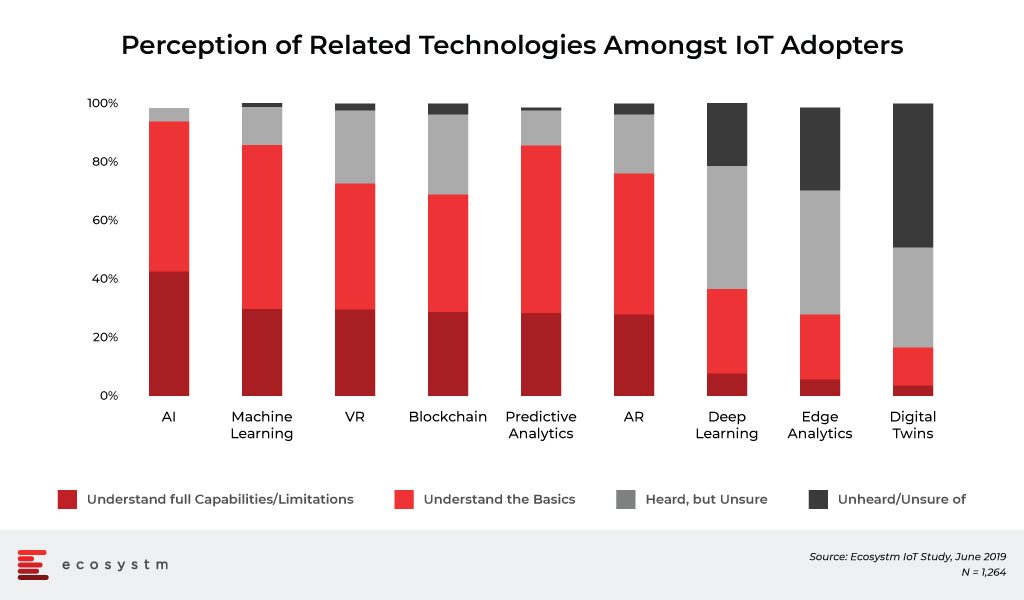
So, if you are still waiting for the IoT boom, this event is a confirmation that IoT is not throwing up many new things at least in Europe. The few IoT companies that exhibited their products and services at Excel London showed nothing that could overshadow the big winner, the ubiquitous father AI.
I have been finding it more difficult to justify coming to these IoT events. However, my role as a speaker and moderator allows me to maintain my influence and keep my followers on social networks, informed. The organisation this year has sought speakers that mix vendor presentations with success stories of clients. But this year neither of them was able to raise the tone of the event. The few large IT firms present such as Microsoft, SAP and Oracle are on the AI bandwagon and their demos on pure-play IoT are oft-repeated.
The larger systems integrators did not have adequate presence either. Many of them should have implemented IoT solutions for years but never really risked investing in IoT, and continue to focus on digitalisation projects, cloud migration projects, products updates and customised developments.
The discussions of the first years of the IoT boom revolved around connectivity, security, IoT platforms, and even business models. Now, nobody is interested in these matters anymore.
There was no significant IoT news during the event. Perhaps the most important announcement was made by Marc Overton who took advantage of his presentation to announce the recent collaboration agreement between Sierra Wireless and Microsoft to claim industry’s first full-stack IoT offerings.
As for my sessions, they mixed IoT and Blockchain, something that would have guaranteed success for attendees two years ago or even last year but that did not arouse great enthusiasm this year. It is evident that both technologies are becoming a commodity. Something that is not bad, since we would stop speculating about possible use cases and actually implement the technology in our lives and businesses.
Do not worry, the life of IoT events continues, and so this week there are three more just in Europe:
- Living bits and Things in Bled (Slovenia), during 17-18th June 2019
- IoT Tech Expo Europe in Amsterdam (Netherlands) during 19-20th June 2019
- IoT Week in Aarhus (Denmark) during 17-21st June 2019
Here is what I think event organisers and Tech vendors should keep in mind:
- Organisers need to find a way to facilitate meetings between vendors and attendants – and focus on how to create indirect lead generation opportunities. This would be mutually beneficial for all concerned.
- Organisers and exhibitors need to try to reinvent these IoT events where we see IoT present in every corner of the floor, in every stage, in every service (cafeteria, rest rooms, transportation….). We need to breath IoT every minute.
- IoT vendors need to demonstrate that they are working with partners and not present isolated use cases or demos. We need to see that “intelligent things” from different vendors in the exhibition area are interconnected.
Otherwise the IoT events will continue to drive away both visitors and exhibitors. What would you like to get out of future IoT events? Let me know.
The largest agricultural event in the southern hemisphere has just come to a close in Waikato New Zealand, across 114 hectares, with over 1,050 exhibitors, more than 125,000 visitors, including delegates from over 40 countries, and total sales revenue of around half a billion over the four days. Fieldays, an idea from the late 1960s focused on connecting farmers with innovative products and services, was officially opened by the Rt. Hon. Jacinda Ardern who spoke of the strength of New Zealand’s primary industry and its importance to the people of New Zealand. Of specific interest to me as I joined the crowds on day two, was the emerging technology innovations in agriculture on show at the Innovation Centre.
A preview of the New Zealand Agritech Story, developed along with New Zealand Trade and Enterprise (NZTE), was kicked off on a foggy Waikato morning on day two of Fieldays, providing insights into the country’s competitive advantage in Agritech along with perceptions of key global players. This was then followed by the New Zealand government announcing a new $20 million Agritech investment venture fund.
NZ Tech reports that the tech sector in New Zealand is the third largest and fastest growing export sector, worth $6.3 billion in 2015, and according to the TIN100, the Waikato, has had the fastest growing tech sector in the country two years in a row. New Zealand Agritech exports stand at $1.4 billion in 2018 and is growing – and together with a strong tech sector overall, the investment will help position New Zealand at the forefront of Agritech innovation globally.
Day two also revealed Fieldays Innovation Award winners across a range of categories including Modusense who took out the Gait International Innovation Award for Product Design and Scalability. Modusense, developed here in the Waikato, is a secure, scalable and reliable Internet of Things (IoT) device platform that provides everything needed to deploy remote data collection. In the primary industries sector, Modusense enables complete apiary health monitoring.
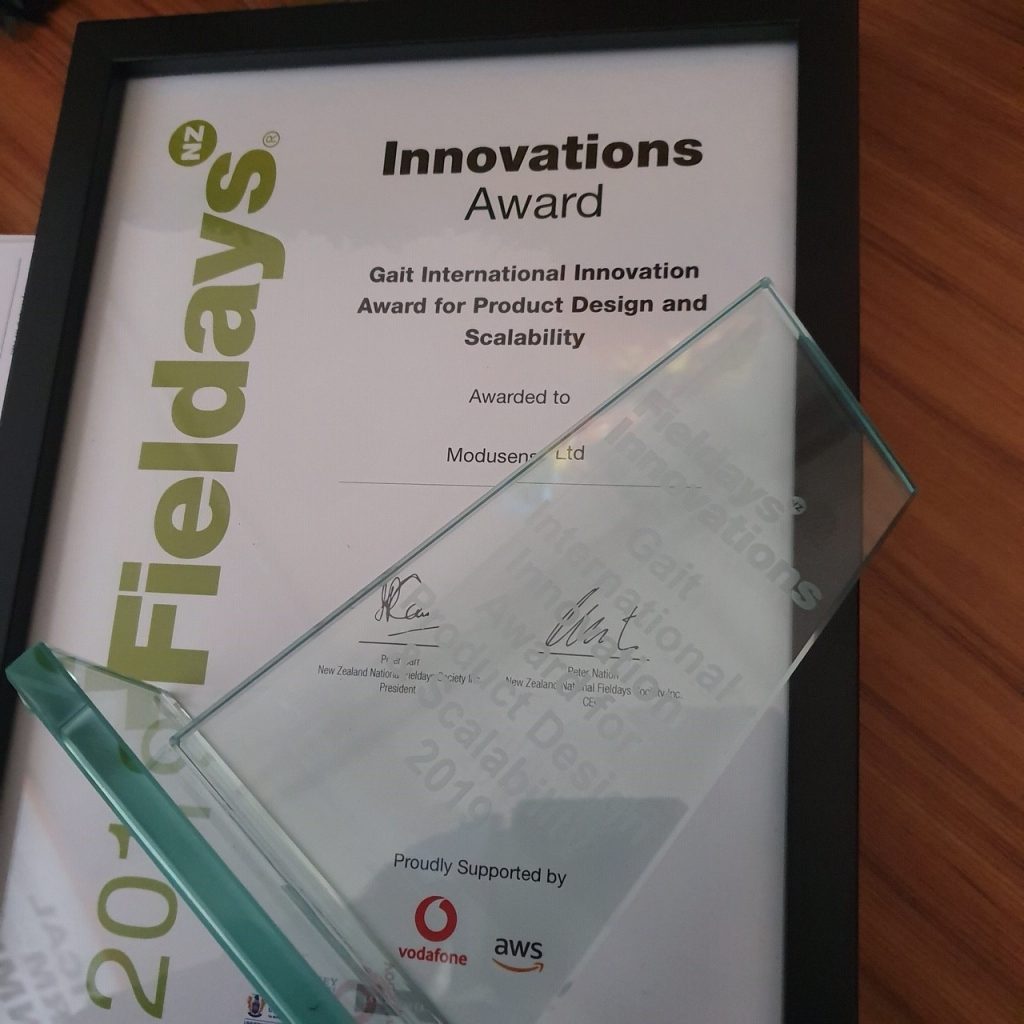
Another IoT enabled solution, RiverWatch, was awarded the AWS Innovation Award in Data for their “Fitbit for water” – an inexpensive water quality monitoring device. RiverWatch is currently running trials in the upper Waikato River in partnership with Te Arawa River Iwi Trust to look at the impacts of industry and farming on water health.
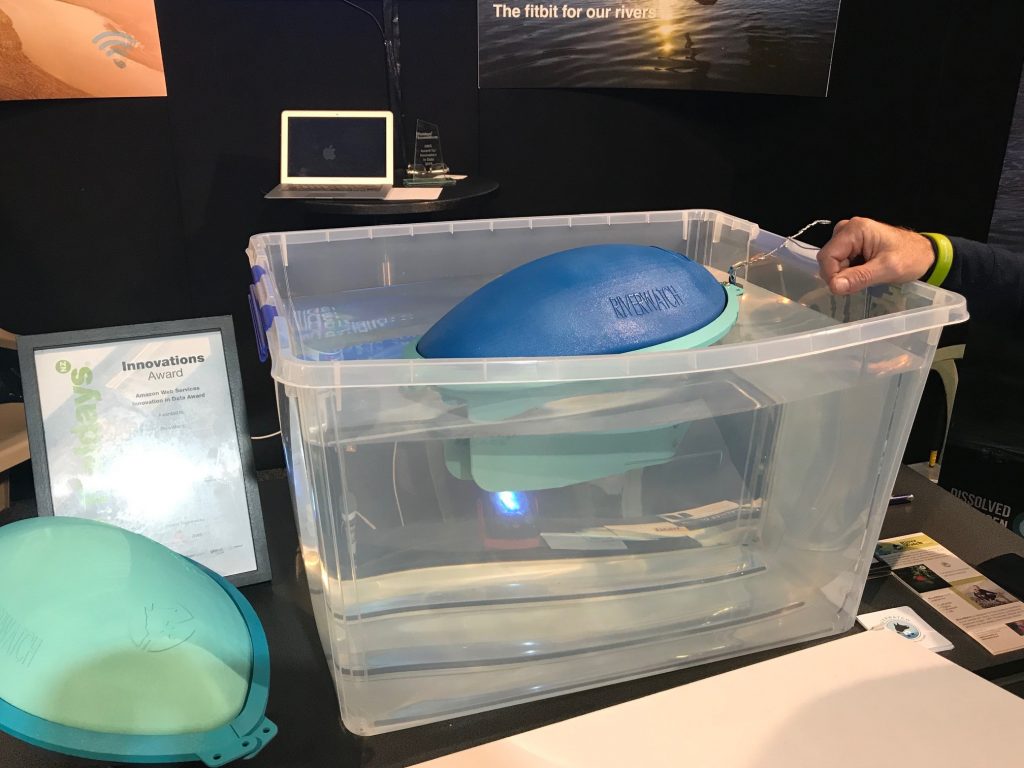
Agritech will transform the industry, and innovations such as those mentioned will further advance New Zealand’s position in the agriculture industry. The true value of Agritech will be realised when AI-enabled IoT is leveraged for cost savings through process automation, and for greater visibility of the entire supply chain. And leading organisations in the industry are aware of it. In the global Ecosystm AI study, Resource & Primary industries (including Agriculture) emerged as a leader when it comes to current and future deployments of IoT Sensor Analytics.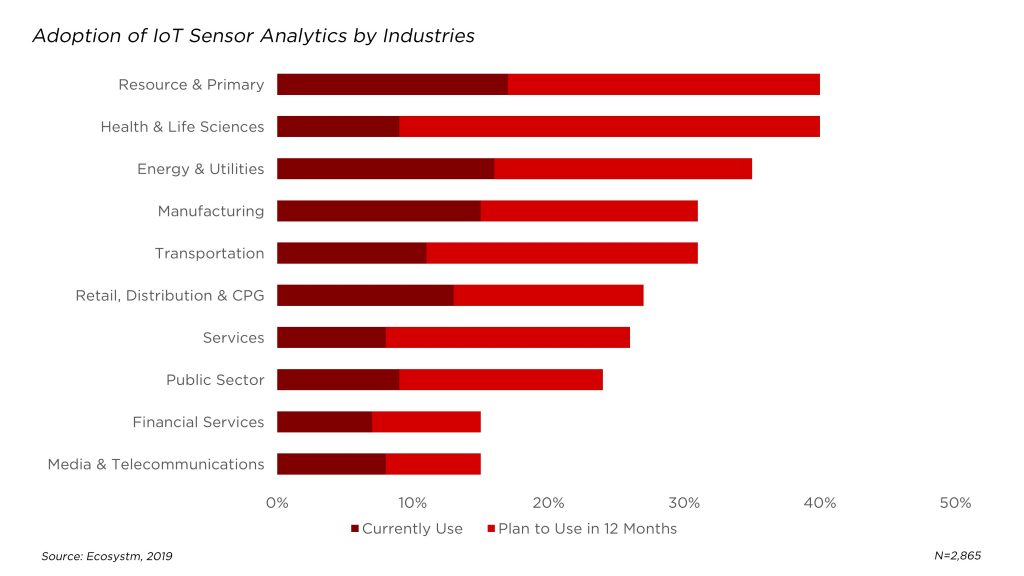
Innovations in IoT
Shipping and logistics in the agricultural sector present unique challenges including a lack of transparency, something that Sparrows.io is working to solve with a hardware and software solution that provides actionable insights using custom sensor modules and live tracking to enable visibility over the supply chain.
The recently launched TRex – IoT, Telemetry, Data and Messaging I/O Transceiver, was also being showcased in the Innovation Centre. Designed to be used for long range monitoring and control, the solution enables two-way messaging and is customisable to meet the needs of applications across various industry sectors including agriculture and farming.
Another innovation that caught my attention at the Innovation Centre was a water monitoring and management device designed to be connected to the irrigation system to enable effective management of water through a mesh network. Hailing from the deep south Next Farm has developed two solutions, with their Remote Irrigation Mesh (RIM) product utilising integrated farm sensor technology together with cloud-based dashboards allowing farmers to maximise the efficiency of water usage while minimising runoff.
Innovations in AI
One of my favourites from last year, Halter, were in the Mystery Creek Pavillion this year and after raising $8 million in funding to refine and further trial their solar-powered collar, for herding cows and monitoring their health, in the Waikato they are close to hitting the open market. Head of Data Science at Halter, Harry She, previously employed by NASA, oversees the development of what the team calls “cowgorithms” which form the basis of the AI underpinning much of the product functions. The collars, which can receive signals up to 8 kms away, is available free and farmers then subscribe on a monthly basis, at a cost per cow, to enable the features they require.
Another product back for another year was the PAWS® Pest Identification Sensor Pad from Lincoln Agritech which is able to identify pests, differentiating these from native species, and transmit the result to the Department of Conservation staff. Utilising machine learning and AI, amongst other technologies, the device greatly reduces surveillance workload and enables staff to detect and respond to re-invasion more rapidly.
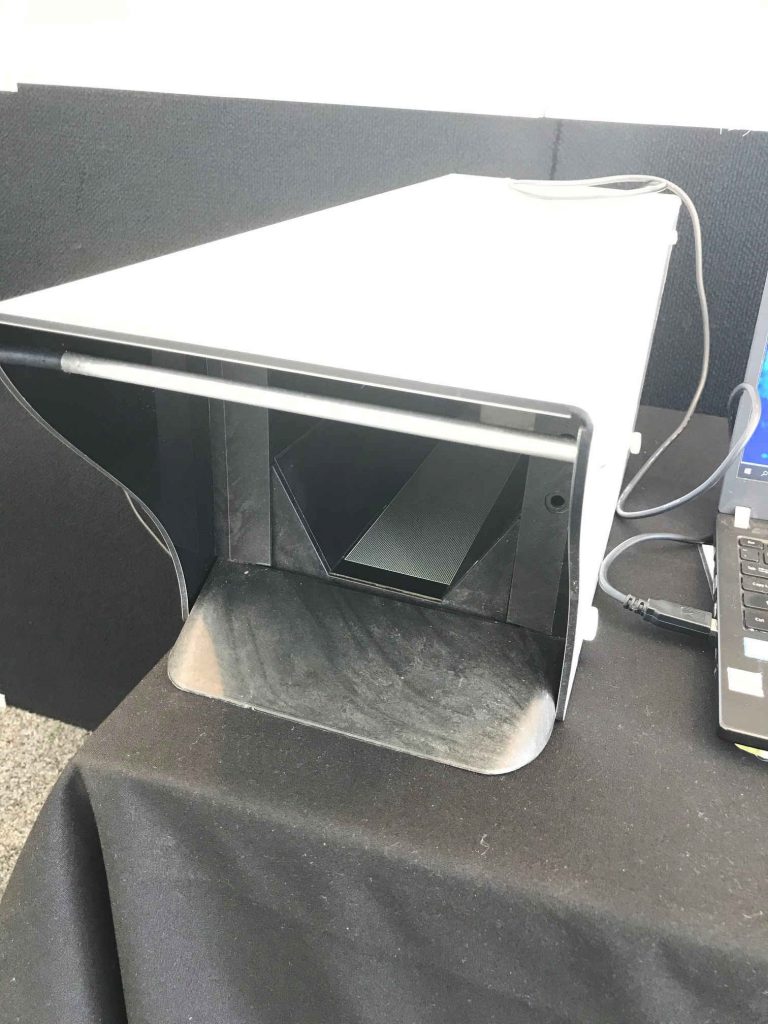
However, as exciting as the idea of a Fitbit for cows and innovation in the pursuit of a predator-free New Zealand is, I must admit the highlight of my Fieldays visit was a team of Agribusiness students from Hamilton’s St Paul’s Collegiate school who were awarded the Fieldays Innovations Young Innovator of the Year Award for their floating electro unit “Bobble Trough” designed to keep animal water troughs clean by preventing the growth of algae and microorganisms through the release of copper ions into the water.
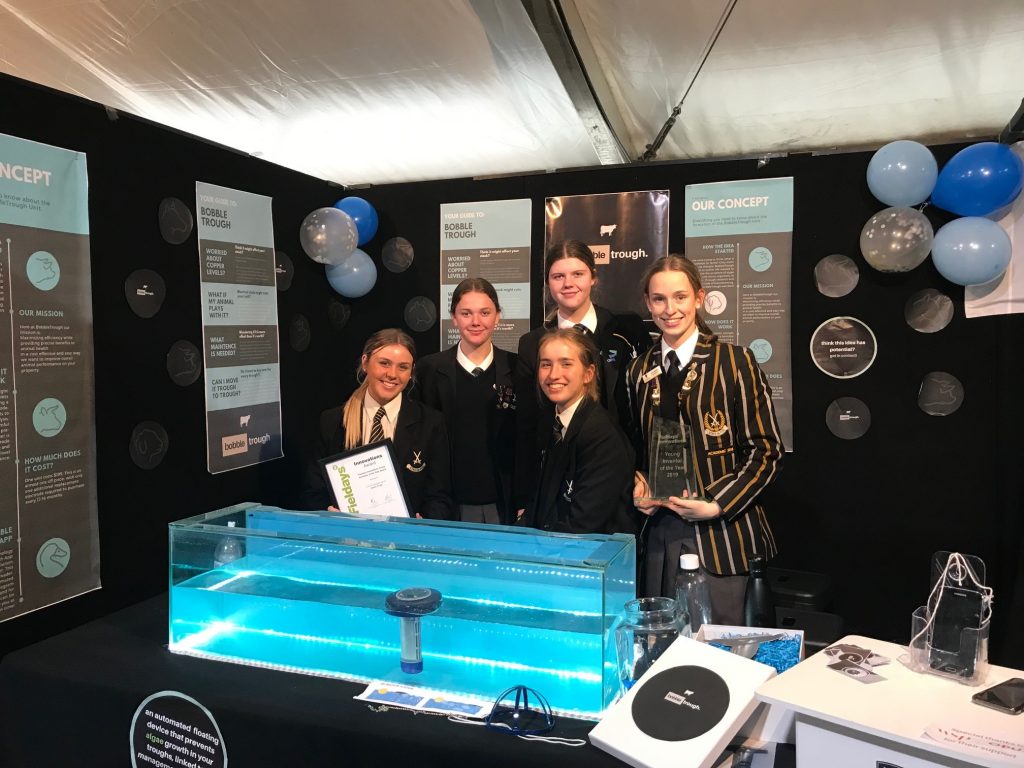
I am now working to secure the team’s innovation as a display in a Smart Space being launched in July as part of the Hamilton City Council’s smart cities initiative, Smart Hamilton. A space designed to provide an opportunity for the wider community to engage with technology innovation and be involved in co-creating solutions that enhance the wellbeing of Hamiltonians.
For information on emerging technology innovation in the agriculture sector in New Zealand access my other reports on technology in agriculture in New Zealand.
Internet of Things (IoT) is changing how companies do business, across industries. Using connected sensors, better data processing capabilities and automation, industries are looking to achieve workforce optimisation, improved customer experience, and cost savings in the short term. In the long-term organisations are looking for service and product innovation, as well as a competitive edge from their IoT investments.
In the global Ecosystm IoT study, participants revealed the IoT solutions that are part of their larger IoT deployment projects. Here are the top 5 solutions that industries are implementing, and how they are benefitting from them.
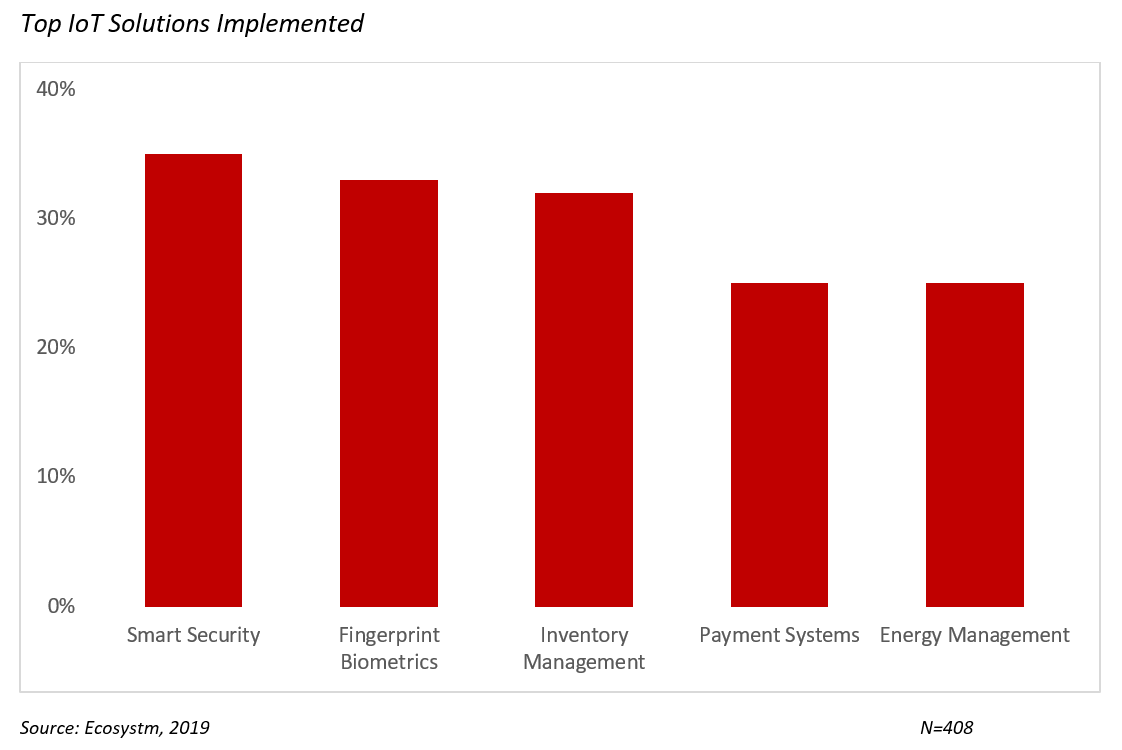
Smart Security
Smart Security is being adopted in several enterprises, especially in the Financial and Hospitality industries. Aside from improved safety, Smart Security solutions have the potential to deliver more personalised service and better customer experience (CX).
Maintaining security for the guests is one of the top concerns for hotels and smart video surveillance systems, motion detection, audio detection, and alert systems are helping hotels to identify possible threats and get early alerts on potential events.
Hotel chains Hilton and Marriott are leveraging Smart Security IoT solutions to create better travel and stay experiences for guests. They are working on creating enhanced security for their visitors by replacing card-based door keys. Simultaneously, smartphone applications connected with hotel sensors and devices are offering a seamless experience to guests with automated room settings such as HVAC, lighting, and blinds.
The Banking industry is incorporating Smart Security as well. Banking and financial institutions attract criminals for obvious reasons and to improve security, smart CCTV surveillance, wedge barriers, laser scanner detectors, light barriers, and quick folding gates are embedded with sensors and connected to safeguard against potential attacks. IoT-enabled network security measures to provide intelligent Perimeter Security is also seeing an uptake in the industry.
However, the proliferation of ubiquitous devices also leaves organisations vulnerable to data breaches. Digital and electronic devices incorporated into a hotel’s infrastructure can be exploited by hackers or may jeopardise the security of guests. The now-famous incident of the casino in the US that was hacked into through the IoT-enabled temperature control system in the fish tank is a case in point.
Fingerprint Biometrics
While Fingerprint Biometrics is often a part of a Smart Security solution, it is being used more often for asset management, as well as access control. This is fairly common in industries where multiple people fill a particular role, such as Manufacturing, Retail, and Healthcare. In hospitals, for example, multiple clinicians work on the same patient order entry system. Using fingerprint biometrics ensures that there is full accountability for care delivery at any given point, irrespective of the clinician.
Biometrics and its application are redefining the banking experience for rural and the unbanked population – in emerging countries especially – as one of the key authentication methods. Biometrics is helping in e-KYC, often used to open a bank account, on-site cash delivery by scanning fingerprints, opening a bank’s wallet with fingerprint authentication, fingerprint-based ATM kiosks and fingerprint mobile ID all connected through the IoT Solutions.
Governments use fingerprint biometrics to accurately authenticate the identity of travelers, implement biometric voting systems for fair and credible elections, develop fingerprint-based national identification cards and create a composite individual identity. But with this advantage, there could be associated challenges of managing personal databases in a safe and secure environment.
Inventory Management
Better supply chain visibility and management is considered one of the most common benefits of IoT deployments, and has use cases in several industries, including Transport & Logistics, and Primary industries. Inventory management became a lot easier and reliable, when IoT sensors and devices can do remote stock taking and track inventory movement.
IoT will enable more holistic inventory management, as asset tracking, asset management and eventually predictive maintenance, are incorporated within the IoT system. Supply chain requirements of Manufacturing organisations can vary vastly – a discrete manufacturing supply chain will vary from a FMCG supply chain. IoT sensors have made ‘track and trace’ more reliable, and easy to customise. eCommerce giant Amazon’s inventory management and warehousing system is a good example. To manage the large stock, the storage facilities employ pickers (robots) to pick items from and replenish stock on shelves which in turn improves receiving, pick-up, and shipping times. The inventory is scanned through barcodes which also helps in aggregating information from other warehouses for stock maintenance.
Several Retail organisations make full use of IoT for inventory management. G-Star Raw, for example, uses garment RFID tags to track inventory movements across the supply chain and store shelves. Being able to locate clothes on the basis of style, colour and size in the stores makes the order fulfillment reliable and more real-time.
Payment Systems
Several industries other than Financial Services, such as Hospitality, Services, Healthcare and Government are evaluating IoT-enabled payment systems such as mobile points of sale and NFC payments.
On most occasions, these are being promoted by financial institutions. As an example, MasterCard has created a Mastercard Engage platform with technology partners resulting in innovations which include contactless payments (with Coin), smart refrigerators that can re-order groceries (with Samsung) and IoT-connected key fobs (with General Motors). Capital One has made it possible for its customers to pay bills via Alexa, whereas Starling is experimenting with integration with Google Home to enable queries on payments and balances on the Google Home platform.
There are also several use cases that are not so obvious –Amazon Go offers a shopping experience where no check-out is required. Your Amazon account, wallet and phone are all inter-connected. When a consumer arrives at a store the application allows store entry, tracks the consumer through the shopping journey and requires no formal check-out at the end of the shopping trip.
However, IoT-enabled payment systems will have to evolve as industries become increasingly services based. There needs to be a focus on the business and not just technology – defining workflows with the right alerts that will automate bill generation and the payment process, irrespective of how complicated the service delivered is.
Energy Management
Resource shortage and the ever-increasing price of energy has forced organisations to identify innovative ways of conserving energy. A Smart energy management system can help to reduce the costs and energy consumption while still meeting energy needs. IoT is helping companies to achieve their energy goals, predict maintenance needs, and increase the reliability of energy assets. Smart energy solutions continuously analyse energy data to ensure dynamic performance which in turn manages energy requirements.
Take an example of a smart building management system where date from various sensors is collected and analysed, such as from HVAC, air-quality monitors, and other equipments, and lighting, heating, air ventilation, elevators, room equipment are remotely operated according to the building energy requirements at the moment. This technology helps make smart decisions and provides energy efficiency.
Capital Tower in Singapore, a 52-storey high building, is not alone in being energy efficient. It has a number of in-built smart energy solutions for energy and water efficiency. The building has motion detectors in elevators, smart car parking system, exterior structure glasses which help reduce energy consumption, and water conservation through condensation of air conditioning units. The building has devices to monitor oxygen and carbon dioxide levels ensuring optimal air quality which results in significant energy savings while delivering comfort for tenants.
As is clear from the solutions that are being currently deployed, IoT adoption is at its nascency. As IoT deployments mature, there will be more industry-specific uses of IoT, and a shift of focus from asset management to people management (including customers).
What IoT solutions do you use/ intend to use in your organisation? Let us know in your comments section below.
This is an abstract of my presentation in Dubai on 23rd April 2019. I want to convey my special thanks to Dr. Eesa Bastaki, President of the University of Dubai for inviting me on the occasion. It was a magnificent experience delivering at such a great University.
In the year 2016, I considered Rio as the first Internet of Things (IoT) Olympic games in my article “The future of “The Internet of Olympic Games”. In Rio, we saw how athletes, coaches, judges, fans, stadiums, and cities benefited from IoT technology and solutions which transformed the way we see and experience sports. Next year we will have another opportunity to validate my predictions for the upcoming Tokyo 2020 Summer Olympics. Therefore, we may designate Tokyo as the first Artificial Intelligent (AI) Olympic Games.
During my presentation at the University of Dubai, I explained to the audience how incredible IoT and AI technologies are and to what extent they are impacting our sports experience. I elaborated on IoT and AI’s significant role in health management, improving aptitude, coaching, and training. These technologies are enabling athletes to improve performance, coaching for better preparation, fewer judgment errors, and a better experience for spectators. I also commented on the importance of IoT and AI to enhance the security of teams, audience, stadium, and cities altogether.
With the use of IoT and AI we are creating a world of smart things transforming sports business where every thousandth part of a second is crucial to predict the outcomes of a race, a match or a bet. I cited various examples on how different sports are utilising IoT and AI, and not in the least I shared a vision of the future that’s like 10-15 years onwards from the present – Can you envision a world of a real and virtual world of sports integrated together? Can you visualise robots and humans or super-humans playing together?
On the other side, speaking of the challenges involved with AI, IoT, and machine learning models for sporting, I conveyed the dark side of these technologies. We cannot forget the fact that the sports industry is a market and therefore enterprises, Governments, and individuals may make erroneous uses of these technologies.
In summary, it in this session I shared my point of view on-
- How IoT and AI will transform coaches, athletes, judges, and fans.
- How IoT and AI will attract the audience to the stadiums
- How IoT and AI will transform the Industry?
- How AI is changing the future of sports betting?
How IoT and AI will transform athletes, coaches, judges and fans?
Athletes
While the true essence of a sport still lies in the talent and perseverance of athletes, it is often no longer enough. Therefore, athletes will continue to demand increasingly sophisticated technologies and cutting-edge training techniques to improve performance. For example, we may see biomechanical machine learning models of players to predict and prevent potential career-threatening physical and mental injuries or can even detect early signs of fatigue or stress-induced injuries. It can also be used to estimate players’ market values to make the right offers while acquiring new talent.
Coaches
Coaches are consuming AI to identify patterns in opponents’ tactics, strengths and weaknesses while preparing for games. This helps coaches to devise detailed game plans based on their assessment of the opposition and maximise the likelihood of victory. In many leading teams, AI systems are used to constantly analyse the stream of data collected by wearables to identify the signs that are indicative of players developing musculoskeletal or cardiovascular problems. This will enable teams to maintain their most valuable assets in prime condition through long competitive seasons.
Judges
We tend to think that technology is helping us to make decisions in sports more accurate and justified. That´s why we look at the inventions such as from Paul Hawkins – creator of Hawk-Eye, a technology that is now an integral part of the spectator’s experience when watching sport live or more recently VAR in soccer.
The use of technology is allowing the decision makers to experience the game with multiple cameras angles in real-time combined with the aggregated data from various sensors (stadiums, things, and athletes) thus making them make more objective and accurate decisions.
We as spectators or fans need more transparency about the exercise’s difficulty, degree of compliance and final score. And we have the technology to do it.
The IoT and AI technology don’t claim to be infallible – just very, very reliable and judges also need to be adapted to new technologies.
Fans
Without fans, sports would find it difficult to exist. It is understandable companies are also targeting fans with IoT and AI to keep them engaged whether in the stadium or at home.
How IoT and AI will attract the audience to the stadiums?
The stadiums, sports clubs and many leagues across the globe are incorporating technologies both inside and outside the stadium areas to boost the unique experiences for fans and not only during the gameplay.
The challenge is how to combine the latest technologies with old-school stuff to please supporters from both newer and older gen. people looking forward to witnessing a game in a stadium?
How will the stadiums of the future be? I read numerous initiatives of big clubs and leagues, but I am excited about the future stadium of Real Madrid. I wish the club would allow me to advise them how to create a smart intelligent Global environment to provide each fan with an individual experience, know who is in the crowd, learn fan behaviors to anticipate their needs.
How IoT and AI will transform the Industry?
“As long as sports remain a fascination for the masses, businesses will always have the opportunity to profit from it. As long as there is profiting to be gained from the world of sports, the investment in and incorporation of technology for sports will continue.”
I went through an article warning about an entirely new world order that is being formed right now. The author explained how 9 companies are responsible for the future of AI. Three of the companies are Chinese (Baidu, Alibaba, and Tencent, often collectively referred to as BAT), while the other six are American (Google, Amazon, IBM, Facebook, Apple, and Microsoft, often referred as the G.Mafia). The reason is obvious, as far as AI is about optimisation using the data that’s available, these 9 companies will manage most of the sports data generated in the world.
Collaboration is needed now to stop this threat and to address the democratisation of AI in sports. It is important that companies and Governments around the globe work together to create guiding principles for the development and use of AI and not only in Sports. This means we need regulations but in a different way. We do not want AI power to lie only in a handful of lawmakers, renowned and smart people who lack skills in IoT and AI.
Will AI change the future of sports betting?
The impact of technology on sports cannot be specifically measured, but some technological innovations do raise questions about fairness. Are we still comparing apples with apples? Is it right to compare the speed of an athlete wearing high-tech running shoes to one without?
Whether we like it or not, technology will continue to enhance the athlete’s performance. And at some point, we will have to put specific rules and regulations in place about which tech enhancements are allowed.
There is a downside to advanced technology being introduced to sports. Nowadays, Machine Learning models are routinely used to predict the results of games. Sports betting is a competitive world itself among fans, but AI can substantially tilt that playing field.
I am afraid that IoT and AI companies may spoil the result predictions but more concerned about the manipulation of competitiveness that AI algorithms could bring with the Terabytes of data collected with IoT devices and other sources like social media networks, without the permission of the users.
The sports industry is already generating billions of dollars every year and without control and awareness, we could find the future generation of ludopaths and a small number of service providers controlling the game.
Let me know what else would you like to see in my future posts. Leave your comments below.
In the last few weeks, there have been announcements in Canada and Denmark on nationwide IoT networks launches. Moving away from pilot projects, test cases, implementations across large factories and campuses or even citywide networks to drive smart city initiatives; these countrywide IoT networks give organisations access to lower cost means to implement large, more integrated, IoT projects.
Sigfox Canada announced the launch of Canada’s first coast to coast low-bandwidth IoT network which is the nation’s first IoT network on such a scale. The network leverages low-power wide area network (LPWAN) technology offering a capacity to support millions of IoT sensors. The solution is anticipated to provide efficient and cost-effective connectivity for businesses looking to adopt IoT technology.
Similarly, Teracom, a Denmark-based telecom operator in partnership with Loriot, (an IoT infrastructure provider) announced an IoT LoRaWAN – Long Range Wide Area Network network in Denmark. We have previously seen the Netherlands implementing a nationwide long range (LoRa) network for IoT and Singtel’s commercially available narrowband Internet of Things (NB-IoT) network in Singapore.
“There is no doubt that services like LoRaWAN will help boost early adoption of IoT services and at this stage, there is a segment of the market which is a good fit. However, the longevity of LoRaWan is less certain. Compared to LoRaWAN, NB-IOT has arguably been too late to the game and it may fail in the short term but may very well win in the long term.” says Copenhagen based Ecosystm Principal Analyst, Claus Mortensen.
Efforts are being made by both the Sigfox and Teracom to enhance the network coverage and quality in the countries. A lot of the focus on IoT in Denmark has been bundled into the future deployment of 5G. However, most IoT applications do not need high bandwidth.
“The issues with large countries such as Canada, Australia, and the US is how do you economically cover large geographic area with a very varied population density? In contrast, smaller countries like Denmark can have a mesh thrown over them very easily” says Ecosystm Executive Analyst, Vernon Turner.
With 5G though, the telecom providers appear to be in a better position as they understand that 5G will be driven by the enterprise segment in the short to medium term and they have been actively involved in developing use cases from the get-go which also includes a focus on IoT services.
IoT offers a plethora of opportunities to companies looking to adopt or expand the country-wide networks. Both mature countries and emerging economies are at dissimilar life-cycles in their degree of IoT technology adoption but we expect to witness more technology sharing and network concatenation in the near-future.
Is the IoT fueling a Digital Ecosystem to enable widespread Digital Transformation?
Ready or not, digital transformation (DX) is here and is already revealing its impact on every aspect of our lives. In some cases, the transformation is obvious. Take the way we call for a ride-share or taxi, find a room to stay, or chat to a robot for your favourite song – these are all part of mainstream DX. More subtle examples, with a Digital Ecosystem working behind the scenes, can be found in things like checking out at the retail store without ever opening your wallet or jumping into the latest automobile and getting your directions mapped out for you.
DX is often described as the integration of digital technology into all areas of business while changing how you operate and deliver value to customers. Advancements involving cloud computing, analytics, social and mobile technologies are reshaping the customer experience (CX) and opening the door for innovation and new business services. DX is also a cultural change that requires organisations to continually experiment with new ideas while being comfortable with failure and accepting that speed has become a business imperative for everyone.
DX will fundamentally change the way we think about creating a product and how we take it to market. Gone are the days of ‘make and sell’— that is, finding a market (after the fact) for the latest bright and shiny invention or innovation and forgetting about the “thing” that’s left behind with the customer. We have flipped from building stagnant technology-for-technology’s sake, as well as having little or no real-time information about most of the product’s lifecycle, to now creating customer-centric solutions teeming with data about everything at all times.
What’s fueling this major shift? The widespread connection of things to the Internet that had never been connected before, including machine-to-machine connectivity. All thanks to embedded smart sensors making IoT an omnipresent phenomenon. By 2025 there will be over 80 billion ‘things’ connected to the Internet which in turn will provide input to feed digitally transformed companies. Industrial business models everywhere will also flip to a ‘sense and respond’ environment where customers and suppliers will know almost everything there is to know about the service or product being sold and delivered to us (within the realms of data privacy regulations).
The Emergence of the Digital Exchange
In the midst of this DX there is vast opportunity: a new customer engagement model to make things better and easier for everyone. Digital businesses cannot be built and serviced by a single supplier – it’s just too complex. There are too many new sources of IoT data that are used to feed business systems and to drive outcomes. Instead, we are seeing businesses that serve the same set of customers from consortia or digital ecosystems or digital exchanges made up of a wide range of participants with an equally wide range of talents and needs.
As more companies become digital, we expect that there will be thousands of ecosystems in existence across every industry. In this collaborative environment, companies with a mutual interest in a particular industry — sometimes crossing traditional industry lines — will join a digital exchange whereby they can openly innovate and scale their business by tapping in to a global community. Just think of the power and value of the exchange as being similar to the network effect (something like Metcalfe’s Law) whereby the more the participants engage in activities in the exchange, the more value everyone gets out of the digital exchange. Microsoft’s Satya Nadella calls this “creating more surplus outside us.”
Some of the key benefits we can expect from the digital exchange are:
- Co-innovation between startups looking for partners and established vendors looking for external ideas for product improvement
- Collaboration to solve like-minded industry challenges
- Creation of open and interoperable tools to speed up new products and services offerings
- Ability to leverage a large and diverse set of partners who can help each other discover new markets and services within their own industry and beyond
Digital exchanges can be wild and confusing, and they may seem disorganised to the newcomer. Think of the first impression you have when you walk into a large open-air market selling antiques. Initially everything seems to be piled into stalls with no logical reason. However, to the experienced shopper and stall owner, there is an organised manner to it that makes sense. And there are many wonderful things waiting to be revealed.
At this year’s Hannover Messe an original example of a digital exchange was rolled out by Schneider Electric called Schneider Electric Exchange — their digital ecosystem and business platform. Schneider Electric Exchange also has a structure to it that is geared up to help specific roles or personas and make it easier for anyone to find the right partner for solving specific business challenges. It is also set up to step someone through the life-cycle process of creating a solution by connecting them to the right tools with the right partners for the right markets. Business value can be created within the Exchange but is equally powerful outside when delivered to the end user. For example, building management designers can use Schneider Electric Exchange to find partners who are also experts of emerging technologies such as digital twins, 3D-Print, AR, and analytics.
We believe that digital exchanges will create immediate economic benefits by reducing friction and inefficiencies in the overall customer supply chain. Participants will be able to innovate faster and deliver quicker — even as customers’ experiences and expectations rise, evolve, and change at the lightning pace of the digital economy. Over time we expect that vendors’ Net Promoter Score (NPS) to rise as a result of improved business processes from these exchanges.
In conclusion, IoT will be the pebble that creates the ripple in the DX pond. Data will be created from every sensor that will be used to create competitive differences at every stage of a company’s value chain. Businesses that do not embrace the use of the data and innovate themselves as well as their products do run the risk of being very quickly disrupted. Companies also do not have the financial and technical resources to do all of this by themselves – hence, the opportunity to be part of a digital exchange is the way to be agile, cost-effective, and competitive. Every time, businesses that waited while a new ‘industrial revolution’ was taking place, lost out. Today, who will dare to disrupt instead of being disrupted? We are at the tipping point of digital transformation and there is no time left to sit on the sidelines – businesses need to jump in to a dynamic digital ecosystem and partner with each other through their industry’s digital exchange!


